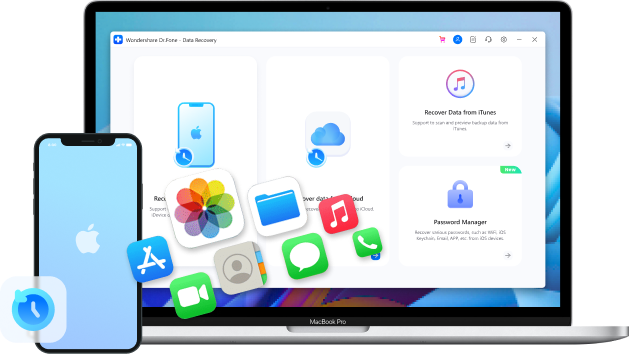
Tips to Recover Photos After Factory Reset iPhone Without Backup
Sep 18, 2025 • Filed to: Data Recovery Solutions • Proven solutions
Many iPhone users face the painful reality of losing data without a backup—often because iCloud only provides 5GB of free storage and iTunes requires manual effort. A factory reset can erase everything permanently, including precious photos. The good news is that solutions exist for iPhone recover photos after factory reset, even without a backup. In this guide, we’ll explain proven recovery methods that work on all models, including the latest iPhone 17, so you can restore your memories with confidence.”

In addition, this guide will provide different ways to back up your iPhone photos. After all, it’s better to be proactive than reactive. So, continue reading.
- Is It Possible to Extract Photos After Factory Reset iPhone Without Backup?
- How to Extract Photos After Factory Reset iPhone Without Backup

- How to Back-Up Your iPhone Before Restore
Is It Possible to Extract Photos After Factory Reset iPhone Without Backup?
Many iPhones, including the latest iPhone 17, can encounter issues such as freezing, crashes, update glitches, or getting stuck on the Apple logo loop. In such cases, performing a factory reset often restores the device to normal working condition. However, a factory reset also wipes out all important data, leaving users at risk of losing precious photos and files permanently. If you forgot to create a backup, don’t panic—there are still effective solutions for iPhone recover photos after factory reset, helping you restore valuable memories even without prior backups.
There are, however, a few third-party data recovery software that scan and back up your lost data. You can install and give them a go to get your favorite and precious memories back.
How to Extract Photos After Factory Reset iPhone Without Backup
Many iOS users sway away from backing up big files like photos, videos, and others, primarily because of limited iCloud storage. For iTunes backup, you must regularly plug your device into your computer to back up your data. It’s troublesome. But in the end, you’re putting your precious memories (photos) at risk of not getting back once deleted or you factory reset your iPhone.
If you want to recover photos after a factory reset iPhone and haven’t created a backup, you need professional data recovery software. Wondersahre Dr.Fone is the most trusted one in the space, with a high recovery rate, multi-platform compatibility, and support for any data type. It also makes recoveries regardless of the condition of your iPhone, whether it is broken, frozen, corrupted, etc.
That’s not it. It has an easy user interface that even an amateur can understand, and it’s private and safe to recover iPhone data after a factory reset. Follow the steps to complete the recovery in a few seconds:
- Step 1: Start the recovery process by installing and launching the Dr. Fone—Data Recovery (iOS) software on your computer. Then, go to Toolbox > Data Recovery to hit the ground running.

- Step 2: As the new screen comes up, select the iOS option as you’re recovering photos from your iPhone.
- Step 3: Continue to tap on “recover Data from an iOS device” from the available options.
- Step 4: The software then prompts you to connect your iPhone to the computer, which you can do by using a USB-C cable or connecting both devices to the same WiFi.
- Step 5: It takes some time to detect the iDevice, and as it does, you’ll see the types of data Dr. Fone can recover. Select the files that got deleted while performing a factory reset, and proceed to tap on the “Start Scan” option in the bottom left corner.
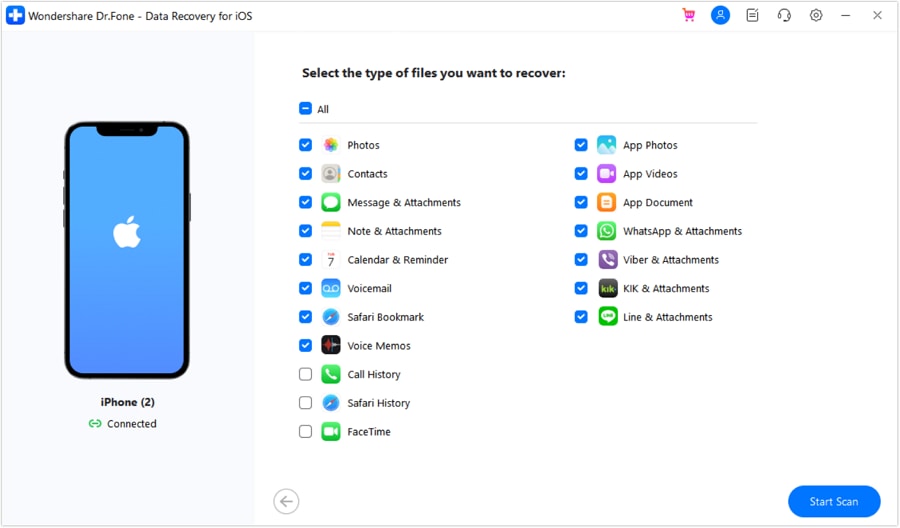
- Step 6: In the next window, the software displays a preview of the files it can recover. You can apply filters to view a certain set of photos, select the photos to recover, and choose to selectively restore your photos and other data. Once you’re content with your selection, tap on “restore to device” or “recover to computer” at the bottom.
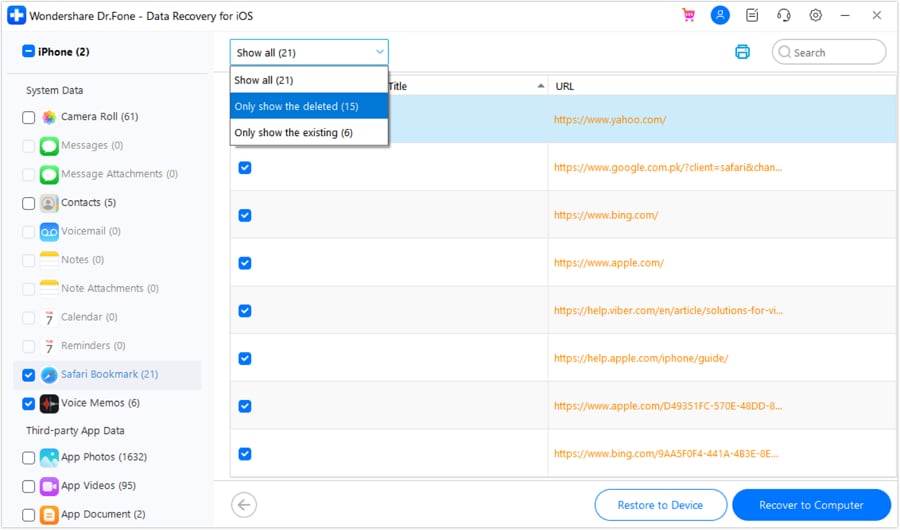
- Step 7: Then, a pop-up window asks the iDevice you wish to restore the data. Select your iDevice and tap on the “Continue” button for Dr. Fone to complete the recovery.
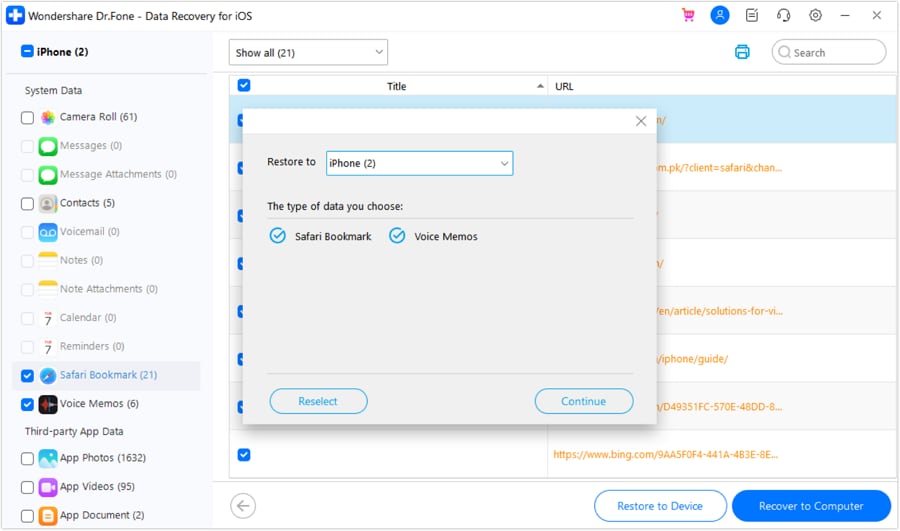
How to Back-Up Your iPhone Before Restore
Although Dr.Fone is an effective tool to recover deleted photos and data with just a few clicks, it can only work if the deleted files haven’t been overwritten by new data. To maximize your chances of success, especially when looking for iPhone recover photos after factory reset on the latest iPhone 17, it’s always safer to back up your device in advance. Here are some recommended backup methods to keep your data secure.
Method 1: Using iCloud
Although iCloud offers limited free space to back up your data, it’s one of the most reliable platforms to use. For that, make sure your device has a seamless internet connection and that there’s enough space available on your iPhone to store your stuff. If everything looks good, follow the steps in order to complete the backup:
- Step 1: On your iPhone, continue to the Settings > [your name]> iCloud.
- Step 2: Find and tap on “iCloud backup.”
- Step 3: Toggle iCloud backup on and tap “Back Up This Phone” to back up all your data from iCloud.

Note: This is the way to set iCloud to automatically backup your data, but that way, you’re likely to run out of space very soon. So what you can do is delete the stuffs that are unnecessarily hogging up the space and delete them to make space for your photos. Here’s what you can do:
1. Delete Old iCloud Backups
Delete your old iCloud backups, i.e., data on devices you no longer have, which are mostly deemed unnecessary as of now. For that, select the backup > Delete Backup > Turn Off & Delete, and a lot of space is cleared in a few clicks.
2. Exclude Apps from Backup
Aside from videos, apps are next on the list of the things that take most space on iCloud, so you can choose to exclude them from the backup. To do so, continue to Settings> Apple ID> iCloud> Manage Storage> Backups, and tap on your device’s icon. Here, it displays your iCloud storage. Look out for the apps taking up the most space, toggle them off, and tap on “Turn off and delete” if needed. Please note that removing an app from its data is also no longer in the backup.
3. Secure Files Locally on the PC
Alternatively, you can use Dr. Fone to back up your iOS data, and unlike iTunes and iCloud, there’s no tussle for space, and backup is completed without needing to plug in your device with the computer.
Method 2: Using Mac
Aside from iCloud, you can use a Mac computer to back up your photos and other important datasets, here’s how:
- Step 1: Connect your iPhone to macOS using a lightning cable and select your device on its Finder sidebar. Please note that you need MacOS 10.15 or later to use Finder, but you can still use iTunes with earlier versions.
- Step 2: Tap on “General” at the top of the Finder window, followed by “Back up all of the data on your iPhone to this Mac.”

- Step 3: The Finder also provides an option to encrypt the backup data and secure it with a password. To do so, select “Encrypt local backup” and then click on “Back Up Now.”
Method 3: Using Windows PC
To backup your iPhone photos using Windows PC, follow the steps in order:
- Step 1: As with the previous method, connect your iPhone to the Windows PC using a USB cable.
- Step 2: Open the iTunes software on your Windows PC and click the iPhone button at the top left corner of the home window.
- Step 3: Click Summary > Back Up Now to store your photos on your Windows PC.
- Step 4: Similar to Mac, you can encrypt your backups here as well. To do so, tap on “Encrypt local backup,” type in a password, and select Set Password.
To view the backups made on your computer, tap Edit> Preferences> Devices, which displays the available backups. Following the above-mentioned methods lets you recover iPhone data after a factory reset, even if your device is stolen.
Conclusion
Although it is possible to recover photos after a factory reset iPhone without backup, ensure to back up your device regularly. Hope the guide helps you to back up and restore your data at any time, even if it’s wiped out completely due to a factory reset. But if you accidentally lose any data that’s not backed up, Wondershare Dr.Fone - Data Recovery (iOS) is a great tool to avoid the risk of potential data loss. You can also use it to seamlessly back up your data.
iPhone Recovery
- Deleted Data Recover
- 1. Recover HEIC Photos on iPhone
- 2. Recover Deleted Calendar Event
- 3. Retrieve iPhone Deleted Reminders
- 4. Retrieve iPhone Deleted Voicemail
- 5. Recover iPhone Deleted Photos
- 6. Recover iPhone Deleted Note
- 7. Recover Call History from iPhone
- 8. Recover iPhone Deleted Contacts
- 9. Recover iPhone Voice Memos
- 10. Recover Deleted iOS Files
- iPhone Passwords Recover
- 1. Retrieve iPhone Email Password
- 2. See iPhone Saved Password
- 3. Access iPhone Password
- 4. Get iPhone Password Back
- 5. iPhone Passcode Requriement Pops
- 6. Find iPhone Wi-Fi Password
- iPhone WhatsApp Recover
- 1. Recover WhatsApp Messages Apps
- 2. Recover Deleted WhatsApp Messages
- 3. Recover WhatsApp Messages Online
- 4. Retrieve Deleted WhatsApp
- Recover from Stolen iPhone
- Recover from Broken iPhone
- 1. Recover Data from Broken iPhone
- 2. Fix iPhone Fell in Water
- 3. Water Damaged iPhone Data Recovery
- 4. Recover Data from Dead iPhone
- 5. Recover Photos From Broken iPhone
- iPhone Recovery Tips
- 1. GT Recovery Undelete Restore
- 2. Recover Data from Memory Card
- 3. Recover iPhone Lost Data
- 4. SD Card Recovery for Mac
- 5. Clear Safari History
- 6. Recover from iPhone in DFU Mode
- 7. iTunes Data Recovery
- 8. Recover iPhone Data Without iTunes
- iPhone Recovery Tools
- ● Manage/transfer/recover data
- ● Unlock screen/activate/FRP lock
- ● Fix most iOS and Android issues
- Recover Now Recover Now Recover Now















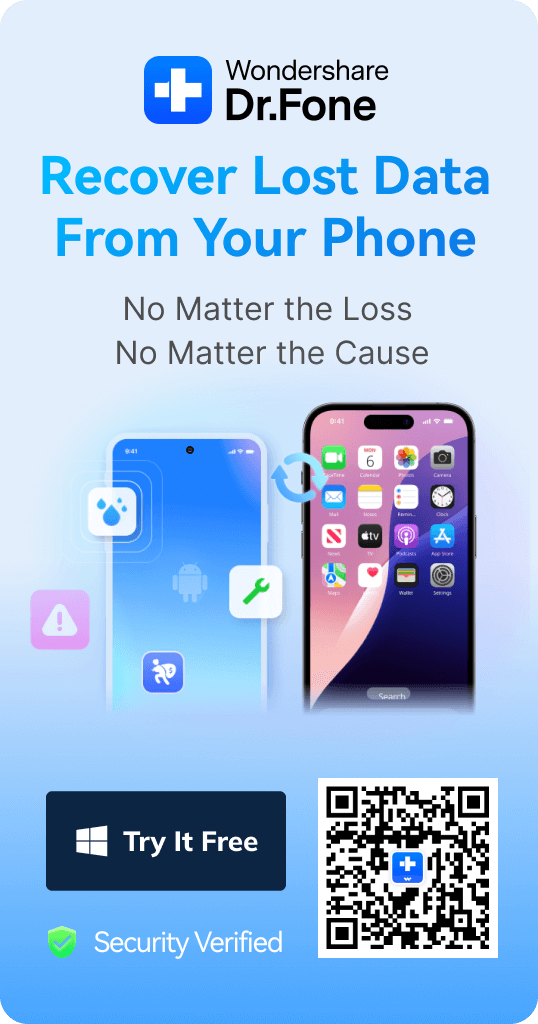

Daisy Raines
staff Editor